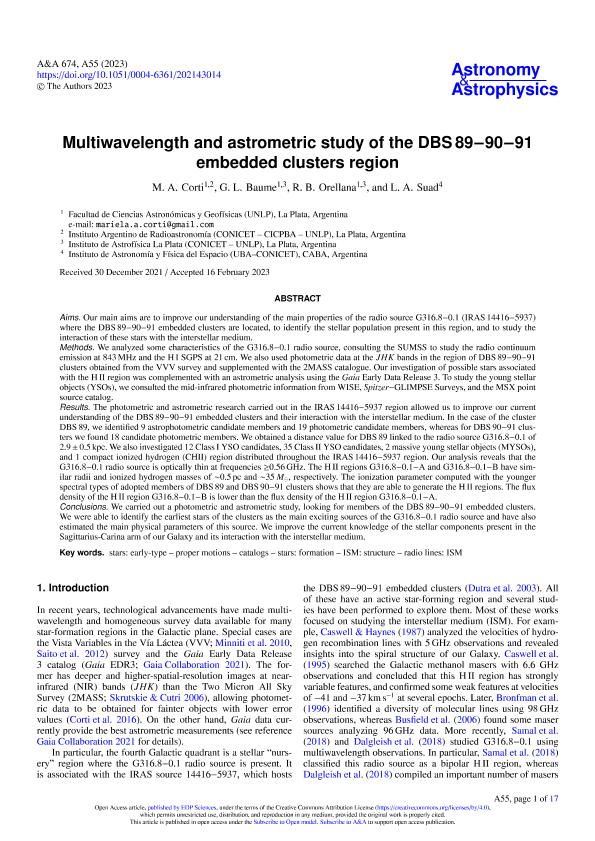Artículo
Multiwavelength and astrometric study of the DBS 89-90-91 embedded clusters region
Fecha de publicación:
02/2023
Editorial:
EDP Sciences
Revista:
Astronomy and Astrophysics
ISSN:
0004-6361
Idioma:
Inglés
Tipo de recurso:
Artículo publicado
Clasificación temática:
Resumen
Aims. Our main aims are to improve our understanding of the main properties of the radio source G316.8-0.1 (IRAS 14416-5937) where the DBS 89-90-91 embedded clusters are located, to identify the stellar population present in this region, and to study the interaction of these stars with the interstellar medium. Methods. We analyzed some characteristics of the G316.8-0.1 radio source, consulting the SUMSS to study the radio continuum emission at 843MHz and the HI SGPS at 21 cm. We also used photometric data at the JHK bands in the region of DBS 89-90-91 clusters obtained from the VVV survey and supplemented with the 2MASS catalogue. Our investigation of possible stars associated with the HII region was complemented with an astrometric analysis using the Gaia Early Data Release 3. To study the young stellar objects (YSOs), we consulted the mid-infrared photometric information from WISE, Spitzer-GLIMPSE Surveys, and the MSX point source catalog. Results. The photometric and astrometric research carried out in the IRAS 14416-5937 region allowed us to improve our current understanding of the DBS 89-90-91 embedded clusters and their interaction with the interstellar medium. In the case of the cluster DBS 89, we identified 9 astrophotometric candidate members and 19 photometric candidate members, whereas for DBS 90-91 clusters we found 18 candidate photometric members. We obtained a distance value for DBS 89 linked to the radio source G316.8-0.1 of 2.9 ± 0.5 kpc.We also investigated 12 Class I YSO candidates, 35 Class II YSO candidates, 2 massive young stellar objects (MYSOs), and 1 compact ionized hydrogen (CHII) region distributed throughout the IRAS 14416-5937 region. Our analysis reveals that the G316.8-0.1 radio source is optically thin at frequencies ≥0.56 GHz. The HII regions G316.8-0.1-A and G316.8-0.1-B have similar radii and ionized hydrogen masses of ~0.5 pc and ~35 M⊙, respectively. The ionization parameter computed with the younger spectral types of adopted members of DBS 89 and DBS 90-91 clusters shows that they are able to generate the HII regions. The flux density of the HII region G316.8-0.1-B is lower than the flux density of the HII region G316.8-0.1-A. Conclusions. We carried out a photometric and astrometric study, looking for members of the DBS 89-90-91 embedded clusters. We were able to identify the earliest stars of the clusters as the main exciting sources of the G316.8-0.1 radio source and have also estimated the main physical parameters of this source. We improve the current knowledge of the stellar components present in the Sagittarius-Carina arm of our Galaxy and its interaction with the interstellar medium.
Archivos asociados
Licencia
Identificadores
Colecciones
Articulos(IAFE)
Articulos de INST.DE ASTRONOMIA Y FISICA DEL ESPACIO(I)
Articulos de INST.DE ASTRONOMIA Y FISICA DEL ESPACIO(I)
Articulos(IALP)
Articulos de INST.DE ASTROFISICA LA PLATA
Articulos de INST.DE ASTROFISICA LA PLATA
Citación
Corti, Mariela Alejandra; Baume, Gustavo Luis; Orellana, Rosa Beatriz; Suad, Laura Andrea; Multiwavelength and astrometric study of the DBS 89-90-91 embedded clusters region; EDP Sciences; Astronomy and Astrophysics; 674; 2-2023; 1-17
Compartir
Altmétricas




